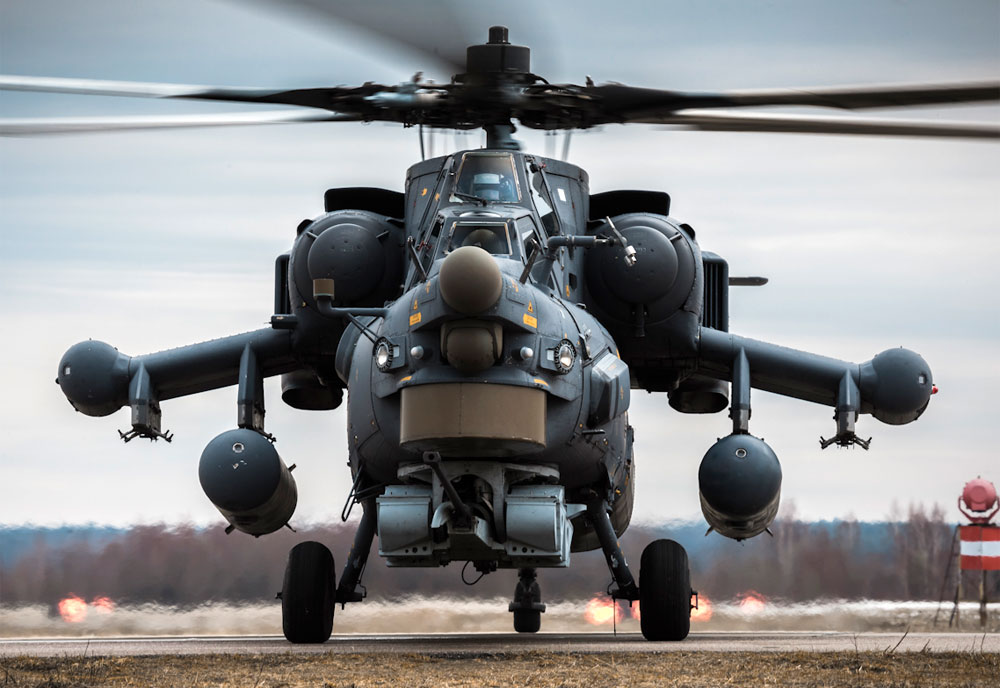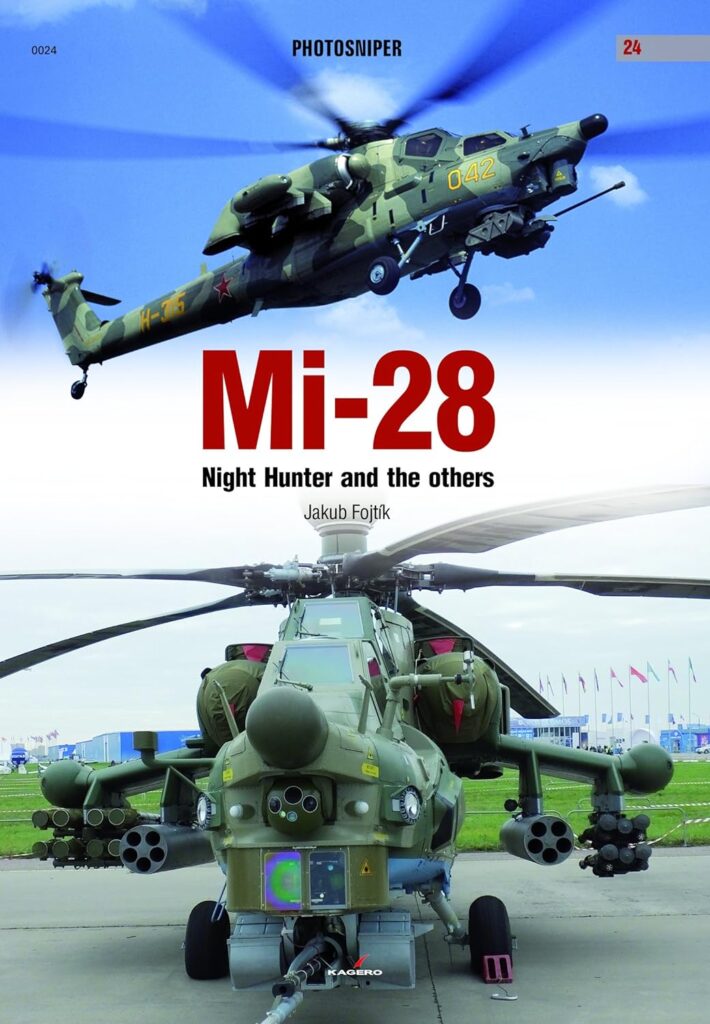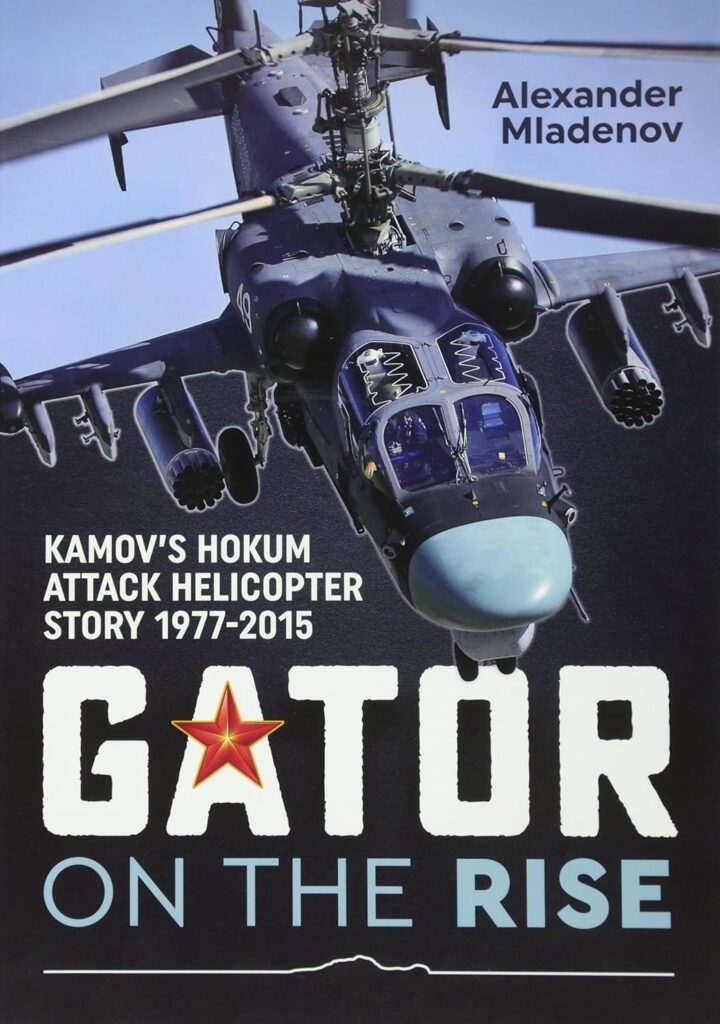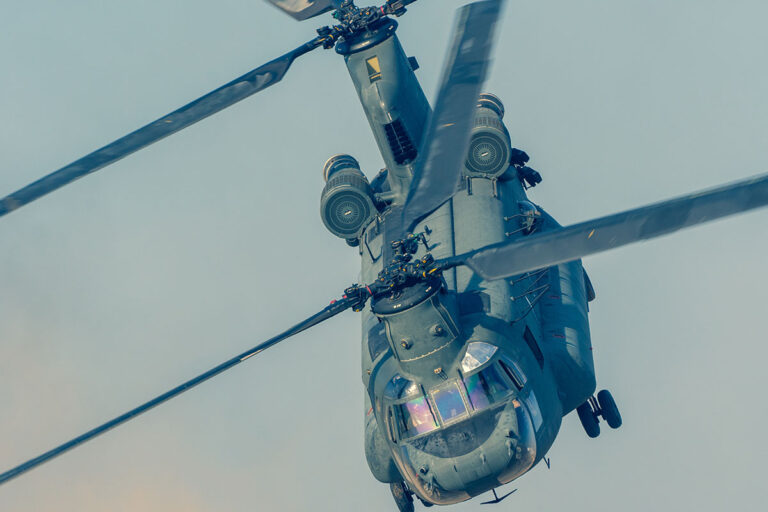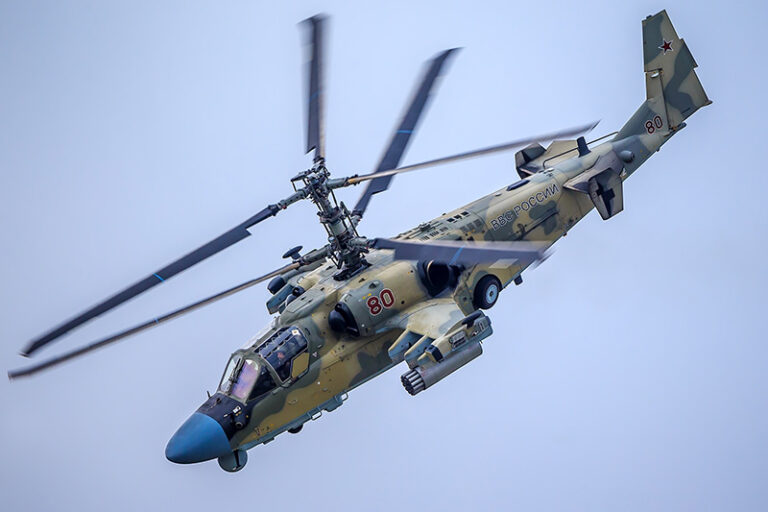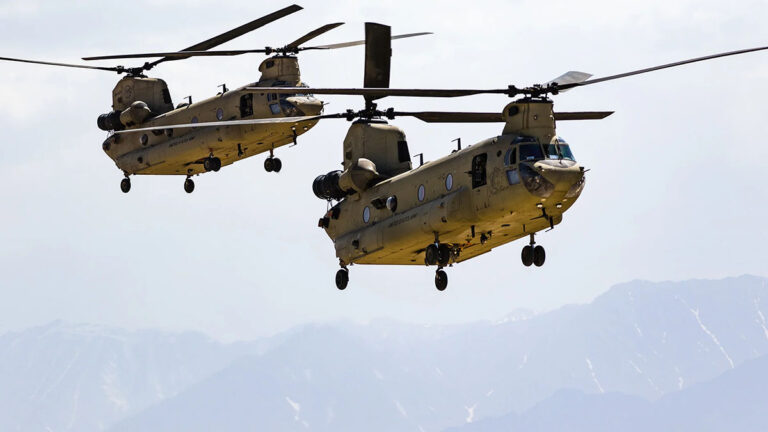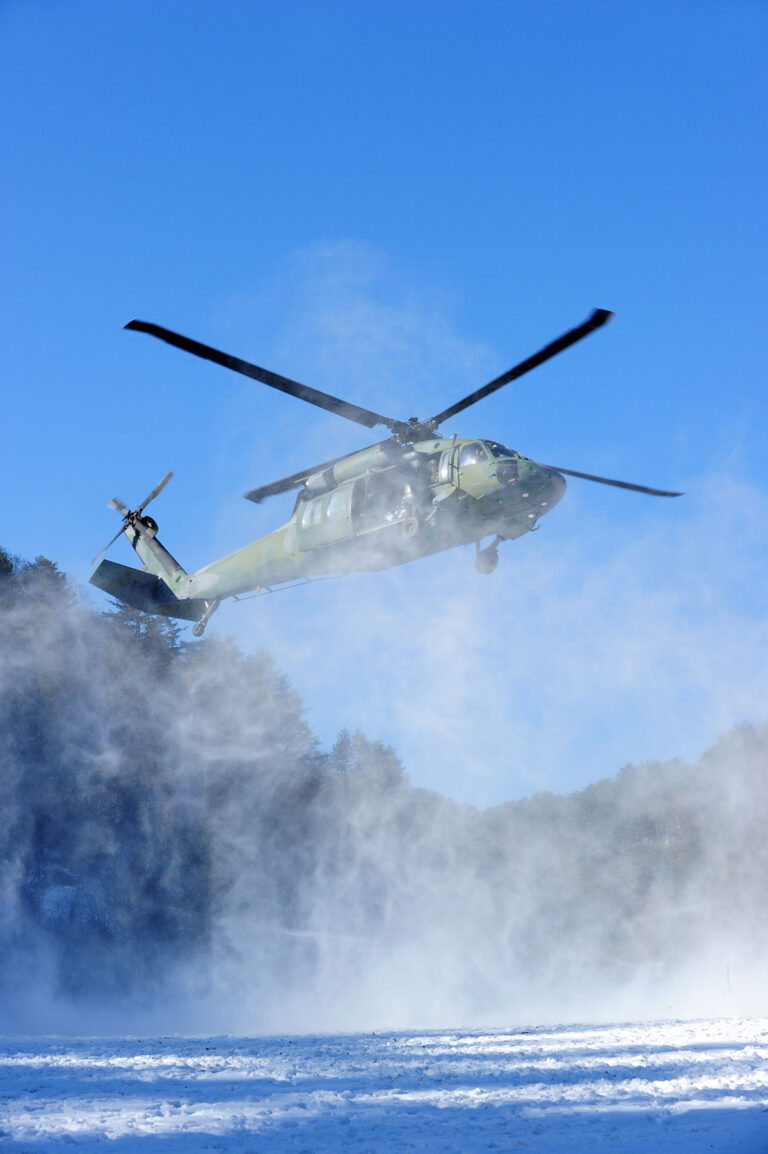The Comprehensive Guide to the Mil Mi-28 Helicopter
Dive Deep into the World of the Mil Mi-28 Helicopter
Welcome to an in-depth exploration of the Mil Mi-28 helicopter, a symbol of aerial prowess and one of the crowning achievements of military aviation. If you’ve ever been intrigued by the sheer power and technological marvels that military helicopters bring to the skies, then you’re in for a treat.
In this comprehensive guide, you’ll journey through the historical evolution of the “Night Hunter,” understanding its origins, key milestones, and its enduring significance in the realm of military aviation. From its technical specifications that make it stand out to its pivotal role in global military operations, every facet of the Mil Mi-28 helicopter is laid out for you.
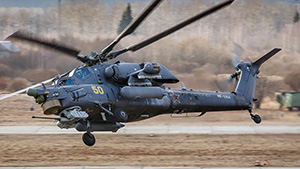
But that’s not all. Delve into the innovative features that set the Mi-28 apart and get an insider’s perspective on how it compares with other iconic helicopters in its class. Understand its global footprint, the nations that trust its capabilities, and peek into the future to see what’s next for this remarkable machine.
By the end of this article, you’ll have gained invaluable insights into the Mil Mi-28 helicopter, appreciating not just its engineering excellence but also its strategic importance in the complex theater of modern warfare.
So, whether you’re a military enthusiast, an avid researcher, or just someone curious about the world of helicopters, this article promises a deep dive that is both engaging and enlightening. Let’s embark on this journey together, soaring high with the legendary Mil Mi-28.
Historical Evolution of the Mil Mi-28 Helicopter
The annals of military aviation are decorated with countless marvels, but few helicopters have made as distinctive a mark as the Mil Mi-28. Dubbed the “Night Hunter” by some, this helicopter has solidified its reputation over the years, serving as a testament to the prowess of Russian engineering. Let’s take a journey through time and explore the historical evolution of the Mil Mi-28 helicopter, uncovering the rich tapestry of its development and ascent to fame.
The Inception: Crafting a New Era of Combat Aviation
In the late 1970s, as the Cold War’s tensions escalated, there was a heightened need for advanced combat helicopters that could dominate the skies. The Soviet Union set out to develop a successor to their earlier models, leading to the conception of the Mil Mi-28 helicopter. Its main purpose? To be an agile, resilient, and lethal force in the air, especially during nocturnal operations.
Mi-28. Night Hunter and others (Photosniper)
The Mil Design Bureau, led by Mikhail Leonteyevich Mil, was one of the leading Soviet plants promoting combination of helicopters and firepower. Mil was personally involved in the development of a prewar A-7 autogyro equipped with a machine gun for its own defense and two more for destroying ground targets. However, this type did not reach mass production. But Mil continued thinking about arming the rotorcraft, especially during his practice design of several Bratukhin helicopters, of which some models were intended for artillery spotting and clearly showed that helicopters could play an important role in the army and could be a part of front line units.
Key Milestones in its Development
- 1982: The maiden flight of the Mil Mi-28, marking its first venture into the skies.
- 1988: The official unveiling of the Mil Mi-28 at the Paris Air Show, showcasing its modern design and advanced features to the world.
- 1990s: Steady refinement and iterations, integrating feedback from test flights and combat simulations. This period saw the incorporation of advanced avionics, safety mechanisms, and a more powerful engine setup.
- 2009: Introduction of the Mil Mi-28N, often termed the “Night Hunter”, equipped with state-of-the-art night vision systems and improved navigational aids.

Transition from Prototype to Mainstay
While the Mil Mi-28 helicopter started as a prototype, challenging competitors like the Kamov Ka-50, its exceptional design and capabilities soon earned it a distinguished spot in military aviation. The journey from its conceptualization to being a mainstay in the fleets of various nations has been nothing short of spectacular.
The Mil Mi-28’s operational history is also interwoven with its competitive edge against other models. Not just in terms of raw performance but also the Mi-28’s adaptability, resilience, and unmatched prowess in both day and night operations.
Recognition on the Global Stage
The Mil Mi-28 helicopter didn’t just cater to domestic military needs. As its reputation grew, so did its demand on the international front. Nations sought the Mil Mi-28, recognizing its blend of power, agility, and combat effectiveness.
Moreover, at events like international air shows and defense exhibitions, the Mil Mi-28 consistently drew attention, further establishing its iconic status.
As we reflect on the Mil Mi-28 helicopter’s historical evolution, it’s evident that this isn’t just a story of a machine—it’s a narrative of innovation, determination, and aviation excellence. The Mil Mi-28 continues to inspire, serving as a beacon of what’s possible when ingenuity meets purpose.
Technical Specifications of the Mil Mi-28 Helicopter
The Mil Mi-28 helicopter, often standing tall amidst its counterparts, isn’t just a feat of design and engineering—it’s a symphony of advanced technology, optimized for combat scenarios. Let’s delve deep into the technical nuances that power this modern-day marvel and understand what makes it a force to reckon with in the skies.
Power and Performance: The Heart of the Night Hunter
At the very core of the Mil Mi-28 helicopter lies its potent powerplant and aerodynamic design, collaborating seamlessly to offer unparalleled flight performance.
- Engine: The Mil Mi-28 is powered by two Klimov TV3-117VMA turboshaft engines, each delivering a staggering 2,200 shp. This ensures the helicopter’s agility and responsiveness, even under challenging conditions.
- Maximum Speed: Cruising through the skies, the Mil Mi-28 can reach top speeds of up to 300 km/h, making swift maneuvers and rapid deployment a breeze.
- Operational Ceiling: With an impressive ceiling of 5,600 meters, the Mil Mi-28 helicopter can navigate diverse terrains and altitudes with ease.
- Range: On a full tank, the Mi-28 boasts a range of approximately 450 km, ensuring prolonged operational capabilities without frequent refuels.
Armament and Defense Systems: The Shield and Sword
The Mil Mi-28 isn’t just about raw flight performance. Its robust armament suite and integrated defense systems ensure it stands its ground in combat zones.
- Primary Weaponry: At its helm, the Mil Mi-28 is equipped with a Shipunov 2A42 30 mm autocannon, perfect for ground engagements. Alongside, it houses ATAKA anti-tank guided missiles and Igla-V air-to-air missiles, making it a formidable opponent in the air.
- Protection Measures: Safety and defense are paramount. The Mil Mi-28 helicopter incorporates composite rotor blades resistant to combat damage and an armored cockpit that shields pilots from projectiles and collision impacts.
Avionics and Navigation: Cutting-Edge Guidance
Modern warfare demands state-of-the-art navigation and communication. The Mi-28 excels here too.
- Radar System: The helicopter features an integrated radar system for terrain following, target detection, and tracking, enhancing its combat prowess in various scenarios.
- Night Operations: True to its nickname, “Night Hunter”, the Mil Mi-28 is equipped with advanced night vision systems, ensuring optimal performance in low-light conditions.
Load Capacity and Dimensions
Understanding the Mil Mi-28’s capacity and size gives us a holistic view of its operational scope:
- Weight: An empty Mi-28 weighs approximately 8,600 kg, with a maximum takeoff weight of around 11,700 kg.
- Dimensions: With a length of 17.01 meters and a main rotor diameter of 17.20 meters, the helicopter’s design prioritizes both agility and stability.
In essence, the Mil Mi-28 helicopter isn’t just another entry in the vast world of aviation. Its technical specifications narrate a story of innovation, precision, and unmatched combat efficiency. Whether you’re an aviation enthusiast or someone eager to understand military marvels, the Mi-28’s intricate details surely captivate and inspire.
Key Features & Innovations of the Mil Mi-28 Helicopter
The Mil Mi-28 helicopter, colloquially known as the “Night Hunter,” isn’t just about power and agility. It’s also about the fusion of ingenious features and groundbreaking innovations that elevate its operational capabilities to new heights. Let’s journey through these distinctive traits and appreciate the forward-thinking engineering that defines the Mil Mi-28.
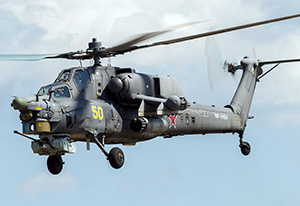
Enhanced Survivability Mechanisms
When it comes to combat situations, resilience and survivability are paramount. The Mil Mi-28 helicopter boasts a suite of features aimed at ensuring the aircraft and its crew remain safe:
- Armored Cockpit: Designed to withstand hits from bullets and shrapnel, the cockpit’s armor provides vital protection to the pilots.
- Crash-Resistant Fuel System: An innovation aimed at reducing risks in case of a crash or projectile impact, enhancing the overall safety of operations.
- Ejection Seats: In critical scenarios, the crew can rely on ejection seats, a rare feature in combat helicopters, ensuring swift and safe exit.
Avionics Prowess
The Mil Mi-28’s avionic suite is a mélange of advanced tech, offering pilots unparalleled situational awareness:
- Integrated Electronic Display System: A cutting-edge feature, offering pilots a consolidated view of essential flight and combat data.
- Helmet-mounted Targeting System: This allows pilots to target adversaries merely by looking at them, ensuring quicker reaction times and enhanced combat efficiency.
Optimized for Night Operations
True to its moniker, the Mil Mi-28 helicopter shines brightest under the cover of darkness:
- Advanced Infra-red Sensors: These provide pilots with clear images even in pitch-dark conditions, ensuring successful missions regardless of the time of day.
- High-Resolution Cameras: Paired with the infra-red sensors, they facilitate precision strikes, especially in stealth operations.
Flexible Weaponry Platform
The Mil Mi-28 is versatile, ready to adapt to the dynamic demands of modern warfare:
- Modular Weapons Mount: This allows for a variety of armaments to be attached, from missiles to gun pods, giving commanders flexibility based on mission requirements.
- Integrated Fire Control System: This ensures each shot counts, optimizing ammunition usage and increasing hit accuracy.
Aerodynamic Excellence
Beyond its features, the Mil Mi-28 helicopter’s design itself is an innovation:
- Coaxial Rotor System: Eliminating the need for a tail rotor, this design aspect provides improved agility and stability, especially in wind-adverse conditions.
- Streamlined Body: Minimizing drag, the sleek design ensures optimal speed and maneuverability during operations.
The Mil Mi-28 helicopter is more than just an assembly of metal, rotors, and engines. It’s a testament to the heights human ingenuity can achieve when pushed by necessity and ambition. Each feature and innovation speak volumes about the foresight and expertise of its creators, ensuring the “Night Hunter” remains an epitome of aerial excellence.
Role of the Mil Mi-28 Helicopter in Military Operations
The Mil Mi-28 helicopter, often revered as the “Night Hunter”, doesn’t just boast remarkable technical specifications or awe-inspiring features; it plays a pivotal role on the battlefield. Serving as a key asset in various military operations, the Mil Mi-28 is a linchpin in modern warfare. Let’s explore the myriad ways in which this helicopter has fortified military strategies and revolutionized aerial combat.
Close Air Support (CAS) Missions
One of the primary roles of the Mil Mi-28 helicopter is providing close air support:
- Target Neutralization: Armed with a potent mix of missiles and a 30 mm autocannon, the Mi-28 excels at neutralizing enemy positions, vehicles, and fortifications from the air.
- Troop Support: Ensuring ground forces have aerial cover, the Mil Mi-28 helicopter is often called upon to safeguard advancing or retreating troops from hostile elements.
Anti-Armor Operations
When armored adversaries threaten ground operations, the Mil Mi-28 swoops in:
- Tank Busting: With its ATAKA anti-tank guided missiles, the helicopter is adept at taking out enemy tanks, ensuring a balance of power on the battlefield.
- Convoys and Logistics Disruption: Beyond the main battle tanks, the Mi-28 is effective against armored personnel carriers and supply trucks, disrupting enemy supply lines and momentum.
Reconnaissance and Surveillance
Beyond direct combat, the Mil Mi-28 helicopter plays a crucial role in intelligence gathering:
- Advanced Radar System: The integrated radar allows for detailed reconnaissance, enabling forces to get real-time intel on enemy positions and movements.
- Night Operations: Thanks to its infra-red sensors and high-resolution cameras, night-time recon is where the “Night Hunter” truly lives up to its name.
Urban Warfare and Counterinsurgency
In modern conflict scenarios, urban warfare and counter-insurgency operations are becoming increasingly prevalent:
- Precision Strikes: In densely populated areas, the Mil Mi-28’s precision weaponry ensures minimal collateral damage while effectively neutralizing threats.
- Rapid Response: Its agility and speed are essential when dealing with insurgent elements, allowing for quick deployment and extraction.
Training and Simulation
Beyond actual warfare, the Mil Mi-28 helicopter plays a part in preparing troops for the real thing:
- Simulation Drills: Its advanced avionics suite allows for simulated combat scenarios, providing invaluable training for pilots and ground controllers.
- Joint Operations: Regular drills with ground forces ensure seamless coordination in real battle conditions, solidifying strategies, and teamwork.
The Mil Mi-28 helicopter isn’t just a machine; it’s an embodiment of strategy, support, and might in aerial combat. Its roles in military operations aren’t just about firing missiles or patrolling skies; it’s about safeguarding troops, gathering intelligence, and ensuring victory on the battlefield. As warfare evolves, so does the “Night Hunter”, continuing to be a force multiplier and a testament to military innovation.
Comparisons of the Mil Mi-28 Helicopter with Other Notable Helicopters
The aviation world is rich with a tapestry of aircraft, each possessing its unique blend of features, capabilities, and operational prowess. Among them, the Mil Mi-28 helicopter, commonly referred to as the “Night Hunter,” has etched its mark as a formidable machine. But how does it fare when pitted against other helicopters of its class? Let’s delve into a comprehensive comparison.
Helicopter Comparison Table
| Feature/Specification | Mil Mi-28 “Night Hunter” | Apache AH-64 | Kamov Ka-50 “Black Shark” | Eurocopter Tiger | Bell AH-1 SuperCobra |
| Top Speed (km/h) | 300 | 293 | 310 | 290 | 278 |
| Primary Armament | ATAKA anti-tank missiles | Hellfire missiles | VIKHR missiles | HAD missile | TOW missiles |
| Pilot Operation | Dual pilot | Dual pilot | Single pilot | Dual pilot | Dual pilot |
| Rotor System | Single main rotor | Single main rotor | Coaxial | Single main rotor | Single main rotor |
| Night Operations | Advanced | Advanced | Moderate | Advanced | Moderate |
| Engine Power (shp) | 2,200 (each) | 1,900 (each) | 2,000 (each) | 1,680 (each) | 1,800 |
| Operational Role | Anti-armor, CAS | Multirole | Attack | Multirole | Attack, CAS |
| Defensive Mechanisms | Armored cockpit, flares | Flares, jammers | Flares, jammers | Flares, jammers | Flares, jammers |
This table offers a snapshot of each helicopter’s capabilities and design elements. To further aid readers, including images of each helicopter above their respective columns and a brief descriptor beneath can provide context immediately. Remember to ensure the table is mobile-responsive, so readers on all devices have a seamless experience.
Mi-28. Night Hunter and others (Photosniper)
The Mil Design Bureau, led by Mikhail Leonteyevich Mil, was one of the leading Soviet plants promoting combination of helicopters and firepower. Mil was personally involved in the development of a prewar A-7 autogyro equipped with a machine gun for its own defense and two more for destroying ground targets. However, this type did not reach mass production. But Mil continued thinking about arming the rotorcraft, especially during his practice design of several Bratukhin helicopters, of which some models were intended for artillery spotting and clearly showed that helicopters could play an important role in the army and could be a part of front line units.
Mil Mi-28 vs. Apache AH-64
The Apache AH-64 helicopter, hailing from the United States, is often seen as one of the primary competitors to the Mil Mi-28:
- Speed: Both helicopters are closely matched, but the Mil Mi-28 helicopter holds a slight edge in top speed.
- Armament: While the Apache boasts the renowned Hellfire missiles, the Mi-28 counters with its versatile ATAKA anti-tank guided missiles.
- Survivability: Both choppers are equipped with state-of-the-art defensive mechanisms, but the Mi-28’s armored cockpit provides an added layer of protection for its pilots.
Mil Mi-28 vs. Kamov Ka-50 “Black Shark”
The Kamov Ka-50 helicopter, another Russian marvel, is an intriguing comparison:
- Design: The most notable difference is the Ka-50’s coaxial rotor system, which offers increased maneuverability, especially in adverse conditions.
- Pilot Operation: Unlike the dual-pilot operation in the Mil Mi-28 helicopter, the Ka-50 is designed for single-pilot operations, emphasizing its role as an attack helicopter.
- Weaponry: Both helicopters have an impressive arsenal, but the Mi-28’s modular weapon mounts offer more versatility in combat scenarios.
Mil Mi-28 vs. Eurocopter Tiger
Europe’s Eurocopter Tiger presents another fascinating face-off:
- Avionics: The Eurocopter Tiger boasts advanced avionics, but the Mi-28’s integrated electronic display system and helmet-mounted targeting give it a competitive edge.
- Engine Power: The Mil Mi-28 helicopter has a more robust engine, allowing it to carry heavier payloads.
- Role Adaptability: While the Tiger is known for its multi-role capabilities, the Mi-28 emphasizes its superiority in anti-armor and close air support missions.
Mil Mi-28 vs. Bell AH-1 SuperCobra
The Bell AH-1 SuperCobra helicopter from the U.S. offers another dimension to this comparison:
- Operational History: The SuperCobra has a longer operational history, but the Mil Mi-28 has incorporated lessons from past conflicts, making it a modern marvel.
- Payload: The Mi-28 comes out on top in terms of payload capacity, enabling a more diverse armament loadout.
- Night Operations: The “Night Hunter” truly shines here with its unparalleled night-time operational capabilities, surpassing the SuperCobra.
In the grand tapestry of combat helicopters, the Mil Mi-28 holds its own as a beacon of design, capability, and operational excellence. Whether compared to western designs or its compatriots, the “Night Hunter” consistently showcases its pedigree and prowess.
Gator On The Rise
The Kamov Ka-50 was developed as a new-generation heavily-armored attack helicopter.The program was launched at the Moscow-based Kamov Experimental Design Bureau in the late 1970s. The concept called for an unorthodox, well-protected, agile and small-size attack machine. It pioneered the Kamov’s trademark co-axial rotor scheme, combined with a highly automated flight/navigation/targeting suite and long-range antitank guided missiles. In the late 1980s – after a protracted head-to-head competition pitted against the Mil Mi-28 – it was judged as being definitely superior to its competitor and was subsequently ordered for serial production.
Current Users and Global Reach of the Mil Mi-28 Helicopter
The world of military aviation is vast and interconnected, with various nations relying on the capabilities of specific aircraft to bolster their defense strategies. The Mil Mi-28 helicopter, or the “Night Hunter” as it’s aptly named, is no exception. As an outstanding piece of aviation engineering, it’s unsurprising that it garners significant attention on the global stage.
Primary Operators
Unveiled during the 1980s, the Mil Mi-28 helicopter swiftly caught the attention of several countries keen on bolstering their aerial combat capabilities:
- Russia: As the birthplace of the Mil Mi-28 helicopter, Russia has integrated the Night Hunter into its fleet with fervor. It serves as a cornerstone of the Russian Air Force, particularly in anti-armor and close air support roles.
- Iraq: In recent years, Iraq has sought to diversify its aerial capabilities. The procurement of the Mil Mi-28 has significantly bolstered their air force, providing a robust response to ground threats.
- Algeria: Recognizing the potency of the Night Hunter, the Algerian Air Force has also adopted the Mi-28, further solidifying its position in North African aerial defense.
Potential and Emerging Users
Several nations, recognizing the Mil Mi-28’s prowess, are currently in discussions or have shown interest:
- India: With its ever-evolving defense needs, India has consistently shown interest in the Mi-28, particularly given its capability in high-altitude regions, a key concern for the country.
- Brazil: Seeking to expand its aerial arsenal, Brazil has eyed the Mil Mi-28 as a potential addition, given its impressive specifications and combat record.
Global Impact
The Mil Mi-28 helicopter isn’t just a machine; it’s a statement. Its presence in international defense exhibitions, such as the MAKS Air Show and the International Military-Technical Forum “ARMY”, underlines its importance in the global defense marketplace.
Moreover, the Night Hunter’s successful operational history, especially in conflict zones, has further highlighted its resilience and capability, making it a sought-after machine for nations prioritizing versatility and durability in their aerial combat units.
Strategic Collaborations and Partnerships
Several global defense entities have collaborated or expressed interest in partnerships related to the Mil Mi-28:
- Rostec: This Russian state-owned conglomerate, encompassing various defense and high-tech industries, has been pivotal in promoting and facilitating the Mi-28’s integration into international markets.
- Rosoboronexport: As Russia’s primary arms export entity, it plays an instrumental role in the global reach of the Mil Mi-28 helicopter, fostering connections and facilitating deals.
In conclusion, the Mil Mi-28 helicopter is not just a testament to Russia’s aviation ingenuity but also a symbol of global defense collaboration. Its presence across various continents underscores its unmatched capability and the trust that nations place in the “Night Hunter.”
Future Developments & Upgrades for the Mil Mi-28 Helicopter
Aircraft technology, especially in the realm of military aviation, is a domain that never stands still. As threats evolve, so does the need for the equipment designed to counter them. The Mil Mi-28 helicopter, renowned for its capabilities, is also on a journey of continuous evolution, keeping pace with the world’s most advanced technologies.
Mi-28NM – The Next Generation
The journey of the Mil Mi-28 helicopter takes an exciting turn with the advent of the Mi-28NM, often referred to as the “Super Night Hunter.” Building on the legacy of its predecessor, this upgrade is all about enhanced capabilities:
- Advanced Avionics: One of the standout features of the Mi-28NM is its revamped avionics suite, promising pilots a more intuitive and streamlined experience. This includes superior navigation systems and a state-of-the-art HUD (Heads-Up Display).
- Enhanced Armament: The Mil Mi-28NM is slated to have an expanded weapons package, which could potentially include new long-range missiles and laser-guided munitions, amplifying its threat response capability.
- Maneuverability: Emphasizing agility, the new variant aims to exhibit improved aerodynamic features and might come equipped with a more powerful engine setup, allowing for faster response and better evasion tactics.
Integration of AI & Drone Technology
In the digital age, AI integration is no longer a luxury but a necessity. For the Mil Mi-28 helicopter, there are whispers of:
- AI-driven Mission Planning: Streamlining the decision-making process, future versions of the Mi-28 might leverage AI for optimizing mission routes, threat assessment, and real-time strategy adjustments.
- Drone Collaborations: The helicopter could operate in tandem with reconnaissance drones, receiving real-time data and enhancing the pilot’s situational awareness drastically.
Defensive & Stealth Upgrades
Protection is paramount in modern warfare:
- Advanced ECM (Electronic Counter Measures): Future iterations of the Mil Mi-28 helicopter are likely to be equipped with enhanced ECM suites, rendering enemy radar, and targeting systems ineffective.
- Stealth Features: Taking a leaf out of fifth-generation fighter aircraft, the Mi-28 might incorporate radar-absorbing materials and design modifications to reduce its radar cross-section, making it a stealthier adversary.
Green Aviation & Efficiency
Sustainability isn’t just a buzzword for commercial flights; it’s making inroads into military aviation as well:
- Fuel Efficiency: The next generation of the Mil Mi-28 might focus on optimizing fuel consumption, translating to longer flight durations, and reduced operational costs.
- Eco-friendly Materials: There’s potential for the incorporation of materials that have a reduced environmental impact, aligning with global sustainability goals.
In essence, while the Mil Mi-28 helicopter already stands as a testament to engineering prowess, its future promises even more marvels. Military enthusiasts and defense analysts alike await with bated breath to witness the next chapter in the saga of the “Night Hunter.”
Conclusion: The Legacy and Future of the Mil Mi-28 Helicopter
Navigating the intriguing and multifaceted world of military aviation, one can’t help but be captivated by the prowess of the Mil Mi-28 helicopter. From its storied history to its expansive global reach, the “Night Hunter” stands as an embodiment of aerial innovation and an emblem of Russian engineering excellence.
The Mi-28 has come a long way since its inception, with each version exhibiting enhancements in tune with the pressing requirements of modern warfare. Whether it’s the precision of its strike capability, its adaptability across diverse terrains, or the trust that numerous nations have placed in it, the Mil Mi-28 helicopter’s reputation is well-deserved.
As we delved into its technical intricacies, the underlying narrative was clear: a commitment to evolution. This commitment isn’t just about keeping up with the times; it’s about anticipating the challenges of tomorrow and preparing for them today. The whispers of AI integration, eco-conscious adaptations, and potential stealth features in its future versions signal a trajectory aimed at maintaining its dominance in the skies.
Furthermore, the Mil Mi-28’s continued significance in international military operations and its role as a comparative benchmark against other military helicopters reiterates its gravitas in defense circles.
For military enthusiasts, defense analysts, and even casual readers, the Mil Mi-28 helicopter serves as a fascinating case study in the confluence of design, functionality, and strategic vision. And as the dawn of the next phase in the Mi-28’s journey beckons, one thing is crystal clear: the legend of the “Night Hunter” is far from over.
In closing, while the wings of time will continue to bring forth new marvels in aviation, the legacy of the Mil Mi-28 helicopter is set to endure, soaring high and casting an influential shadow across the annals of military aviation history.
Frequently Asked Questions
The Mil Mi-28 helicopter, with its rich heritage and advanced features, often garners a plethora of inquiries from military enthusiasts, defense analysts, and the public. In this section, we’ve compiled some of the most common questions to provide a deeper understanding of this remarkable machine.
1. What is the primary role of the Mil Mi-28 helicopter?
The Mil Mi-28, colloquially known as the “Night Hunter,” is primarily an attack helicopter. Designed to perform search and destroy operations against tanks, armored vehicles, enemy infantry, and other ground targets, it plays a pivotal role in modern warfare scenarios.
2. How does the Mil Mi-28 compare to its counterparts like the Apache AH-64?
Both the Mi-28 and the Apache AH-64 are esteemed attack helicopters with a myriad of capabilities. While the Apache has been lauded for its advanced avionics and fire control systems, the Mi-28 boasts impressive armor protection and agility in the air. A side-by-side comparison, as detailed in the earlier sections, provides a more comprehensive view of their respective strengths.
3. Which countries currently deploy the Mil Mi-28 helicopter in their defense forces?
Several countries, recognizing the strategic importance of the Mi-28, have incorporated it into their defense arsenal. This includes Russia, Iraq, Algeria, and Nigeria, among others. The helicopter’s global reach is a testament to its versatility and performance.
4. Are there civilian applications for the Mil Mi-28?
While primarily designed for military operations, the technologies developed for the Mil Mi-28 helicopter have found applications in other domains, such as search and rescue operations or disaster relief. However, the Mi-28 itself remains a predominantly military asset.
5. What are the expected upgrades in the future versions of the Mi-28?
The future for the Mil Mi-28 helicopter is rife with promise. Expected upgrades include advanced AI-driven mission planning, enhanced Electronic Counter Measures (ECM), potential stealth features, and improved fuel efficiency. For a detailed look, refer to our section on “Future Developments & Upgrades.”
6. Why is the Mil Mi-28 often called the “Night Hunter”?
The “Night Hunter” moniker is derived from the helicopter’s prowess in night operations. Equipped with advanced night vision systems and the capability to engage targets with precision in low-light conditions, the Mi-28 truly earns its epithet.
In sum, the Mil Mi-28 helicopter, with its compelling mix of history, innovation, and strategic importance, continues to captivate minds worldwide. These FAQs only scratch the surface, and we invite readers to delve deeper, exploring the multifaceted journey of this iconic aircraft.


